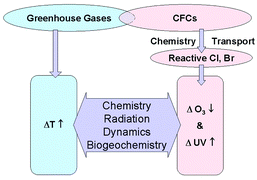Since publication of the 1998 UNEP Assessment, there has been continued rapid expansion of the literature on UV-B radiation. Many measurements have demonstrated the inverse relationship between column ozone amount and UV radiation, and in a few cases long-term increases due to ozone decreases have been identified. The quantity, quality and availability of ground-based UV measurements relevant to assessing the environmental impacts of ozone changes continue to improve. Recent studies have contributed to delineating regional and temporal differences due to aerosols, clouds, and ozone. Improvements in radiative transfer modelling capability now enable more accurate characterization of clouds, snow-cover, and topographical effects.
A standardized scale for reporting UV to the public has gained wide acceptance. There has been increased use of satellite data to estimate geographic variability and trends in UV. Progress has been made in assessing the utility of satellite retrievals of UV radiation by comparison with measurements at the Earth's surface. Global climatologies of UV radiation are now available on the Internet.
Anthropogenic aerosols play a more important role in attenuating UV irradiances than has been assumed previously, and this will have implications for the accuracy of UV retrievals from satellite data. Progress has been made inferring historical levels of UV radiation using measurements of ozone (from satellites or from ground-based networks) in conjunction with measurements of total solar radiation obtained from extensive meteorological networks.
We cannot yet be sure whether global ozone has reached a minimum. Atmospheric chlorine concentrations are beginning to decrease. However, bromine concentrations are still increasing. While these halogen concentrations remain high, the ozone layer remains vulnerable to further depletion from events such as volcanic eruptions that inject material into the stratosphere. Interactions between global warming and ozone depletion could delay ozone recovery by several years, and this topic remains an area of intense research interest.
Future changes in greenhouse gases will affect the future evolution of ozone through chemical, radiative, and dynamic processes. In this highly coupled system, an evaluation of the relative importance of these processes is difficult; studies are ongoing. A reliable assessment of these effects on total column ozone is limited by uncertainties in lower stratospheric response to these changes.
At several sites, changes in UV differ from those expected from ozone changes alone, possibly as a result of long-term changes in aerosols, snow cover, or clouds. This indicates a possible interaction between climate change and UV radiation. Cloud reflectance measured by satellite has shown a long-term increase at some locations, especially in the Antarctic region, but also in Central Europe, which would tend to reduce the UV radiation.
Even with the expected decreases in atmospheric chlorine, it will be several years before the beginning of an ozone recovery can be unambiguously identified at individual locations. Because UV-B is more variable than ozone, any identification of its recovery would be further delayed.


 Please wait while we load your content...
Please wait while we load your content...